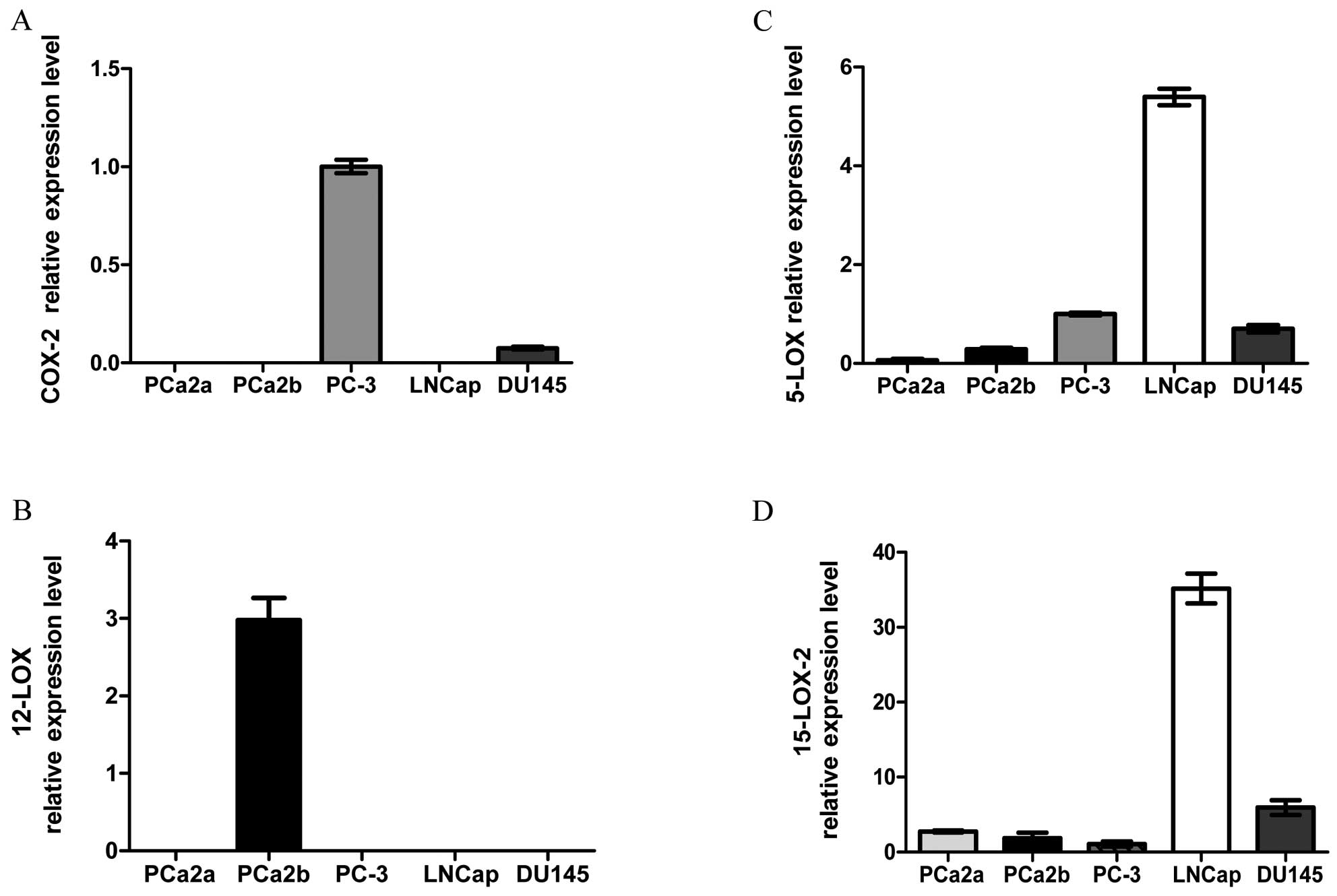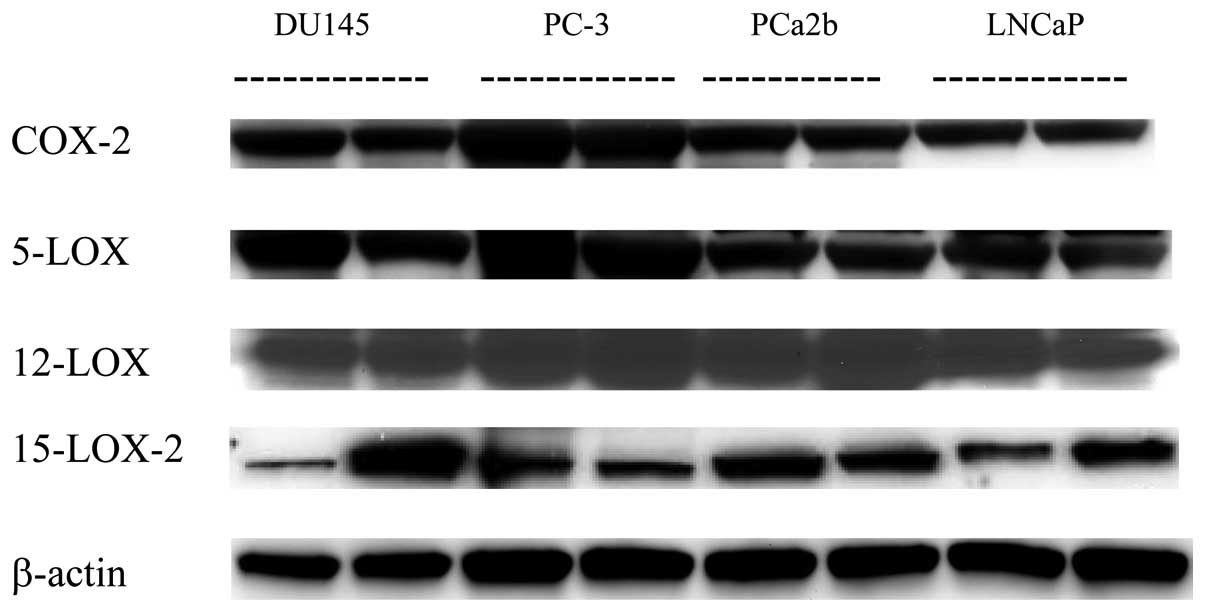|
1
|
Baade PD, Youlden DR and Krnjacki LJ:
International epidemiology of prostate cancer: geographical
distribution and secular trends. Mol Nutr Food Res. 53:171–184.
2009. View Article : Google Scholar : PubMed/NCBI
|
|
2
|
Coleman MP, Quaresma M, Berrino F, et al:
Cancer survival in five continents: a worldwide population-based
study (CONCORD). Lancet Oncol. 9:730–756. 2008. View Article : Google Scholar : PubMed/NCBI
|
|
3
|
Crowe FL, Key TJ, Appleby PN, et al:
Dietary fat intake and risk of prostate cancer in the European
Prospective Investigation into Cancer and Nutrition. Am J Clin
Nutr. 87:1405–1413. 2008.
|
|
4
|
Bidoli E, Talamini R, Bosetti C, et al:
Macronutrients, fatty acids, cholesterol and prostate cancer risk.
Ann Oncol. 16:152–157. 2005. View Article : Google Scholar : PubMed/NCBI
|
|
5
|
Rose DP and Connolly JM: Effects of fatty
acids and eicosanoid synthesis inhibitors on the growth of two
human prostate cancer cell lines. Prostate. 18:243–254. 1991.
View Article : Google Scholar : PubMed/NCBI
|
|
6
|
Pandalai PK, Pilat MJ, Yamazaki K, Naik H
and Pienta KJ: The effects of omega-3 and omega-6 fatty acids on in
vitro prostate cancer growth. Anticancer Res. 16:815–820.
1996.PubMed/NCBI
|
|
7
|
Chaudry AA, Wahle KW, McClinton S and
Moffat LE: Arachidonic acid metabolism in benign and malignant
prostatic tissue in vitro: effects of fatty acids and
cyclooxygenase inhibitors. Int J Cancer. 57:176–180. 1994.
View Article : Google Scholar : PubMed/NCBI
|
|
8
|
Anderson KM, Wygodny JB, Ondrey F and
Harris J: Human PC-3 prostate cell line DNA synthesis is suppressed
by eicosatetraynoic acid, an in vitro inhibitor of arachidonic acid
metabolism. Prostate. 12:3–12. 1988. View Article : Google Scholar : PubMed/NCBI
|
|
9
|
Berquin IM, Min Y, Wu R, et al: Modulation
of prostate cancer genetic risk by omega-3 and omega-6 fatty acids.
J Clin Invest. 117:1866–1875. 2007. View Article : Google Scholar : PubMed/NCBI
|
|
10
|
Higgs GA, Moncada S and Vane JR:
Eicosanoids in inflammation. Ann Clin Res. 16:287–299. 1984.
|
|
11
|
Wallace JM: Nutritional and botanical
modulation of the inflammatory cascade--eicosanoids,
cyclooxygenases, and lipoxygenases--as an adjunct in cancer
therapy. Integr Cancer Ther. 1:7–37. 2002.PubMed/NCBI
|
|
12
|
Hughes-Fulford M, Chen Y and Tjandrawinata
RR: Fatty acid regulates gene expression and growth of human
prostate cancer PC-3 cells. Carcinogenesis. 22:701–707. 2001.
View Article : Google Scholar : PubMed/NCBI
|
|
13
|
Subbarayan V, Sabichi AL, Llansa N,
Lippman SM and Menter DG: Differential expression of
cyclooxygenase-2 and its regulation by tumor necrosis factor-alpha
in normal and malignant prostate cells. Cancer Res. 61:2720–2726.
2001.PubMed/NCBI
|
|
14
|
Tang K and Honn KV: 12(S)-HETE in cancer
metastasis. Adv Exp Med Biol. 447:181–191. 1999. View Article : Google Scholar : PubMed/NCBI
|
|
15
|
Yin B, Yang Y, Zhao Z, et al: Arachidonate
12-lipoxygenase may serve as a potential marker and therapeutic
target for prostate cancer stem cells. Int J Oncol. 38:1041–1046.
2011.PubMed/NCBI
|
|
16
|
Ghosh J and Myers CE: Inhibition of
arachidonate 5-lipoxygenase triggers massive apoptosis in human
prostate cancer cells. Proc Natl Acad Sci USA. 95:13182–13187.
1998. View Article : Google Scholar
|
|
17
|
Tang S, Bhatia B, Maldonado CJ, et al:
Evidence that arachidonate 15-lipoxygenase 2 is a negative cell
cycle regulator in normal prostate epithelial cells. J Biol Chem.
277:16189–16201. 2002. View Article : Google Scholar : PubMed/NCBI
|
|
18
|
Shureiqi I, Chen D, Lee JJ, et al:
15-LOX-1: a novel molecular target of nonsteroidal
anti-inflammatory drug-induced apoptosis in colorectal cancer
cells. J Natl Cancer Inst. 92:1136–1142. 2000. View Article : Google Scholar : PubMed/NCBI
|
|
19
|
Vanaja DK, Grossmann ME, Celis E and Young
CY: Tumor prevention and antitumor immunity with heat shock protein
70 induced by 15-deoxy-delta12,14-prostaglandin J2 in transgenic
adenocarcinoma of mouse prostate cells. Cancer Res. 60:4714–4718.
2000.
|
|
20
|
Wang MT, Honn KV and Nie D:
Cyclooxygenases, prostanoids, and tumor progression. Cancer
Metastasis Rev. 26:525–534. 2007. View Article : Google Scholar : PubMed/NCBI
|
|
21
|
Dassesse T, de Leval X, de Leval L,
Pirotte B, Castronovo V and Waltregny D: Activation of the
thromboxane A2 pathway in human prostate cancer correlates with
tumor Gleason score and pathologic stage. Eur Urol. 50:1021–1031.
2006. View Article : Google Scholar : PubMed/NCBI
|
|
22
|
Nie D, Guo Y, Yang D, et al: Thromboxane
A2 receptors in prostate carcinoma: expression and its role in
regulating cell motility via small GTPase Rho. Cancer Res.
68:115–121. 2008. View Article : Google Scholar : PubMed/NCBI
|
|
23
|
Nie D, Che M, Zacharek A, et al:
Differential expression of thromboxane synthase in prostate
carcinoma: role in tumor cell motility. Am J Pathol. 164:429–439.
2004. View Article : Google Scholar : PubMed/NCBI
|
|
24
|
Wang X, Colby JK, Yang P, Fischer SM,
Newman RA and Klein RD: The resistance to the tumor suppressive
effects of COX inhibitors and COX-2 gene disruption in TRAMP mice
is associated with the loss of COX expression in prostate tissue.
Carcinogenesis. 29:120–128. 2008. View Article : Google Scholar : PubMed/NCBI
|
|
25
|
Shappell SB, Olson SJ, Hannah SE, et al:
Elevated expression of 12/15-lipoxygenase and cyclooxygenase-2 in a
transgenic mouse model of prostate carcinoma. Cancer Res.
63:2256–2267. 2003.PubMed/NCBI
|
|
26
|
Shappell SB, Manning S, Boeglin WE, et al:
Alterations in lipoxygenase and cyclooxygenase-2 catalytic activity
and mRNA expression in prostate carcinoma. Neoplasia. 3:287–303.
2001. View Article : Google Scholar : PubMed/NCBI
|
|
27
|
Bhatia B, Maldonado CJ, Tang S, et al:
Subcellular localization and tumor-suppressive functions of
15-lipoxygenase 2 (15-LOX2) and its splice variants. J Biol Chem.
278:25091–25100. 2003. View Article : Google Scholar : PubMed/NCBI
|
|
28
|
Navone NM, Olive M, Ozen M, et al:
Establishment of two human prostate cancer cell lines derived from
a single bone metastasis. Clin Cancer Res. 3:2493–2500.
1997.PubMed/NCBI
|
|
29
|
Pfaffl MW: A new mathematical model for
relative quantification in real-time RT-PCR. Nucleic Acids Res.
29:e452001. View Article : Google Scholar : PubMed/NCBI
|
|
30
|
Shureiqi I, Zuo X, Broaddus R, et al: The
transcription factor GATA-6 is overexpressed in vivo and
contributes to silencing 15-LOX-1 in vitro in human colon cancer.
FASEB J. 21:743–753. 2007. View Article : Google Scholar : PubMed/NCBI
|
|
31
|
Kempen EC, Yang P, Felix E, Madden T and
Newman RA: Simultaneous quantification of arachidonic acid
metabolites in cultured tumor cells using high-performance liquid
chromatography/electrospray ionization tandem mass spectrometry.
Anal Biochem. 297:183–190. 2001. View Article : Google Scholar
|
|
32
|
Yang P, Felix E, Madden T, Fischer SM and
Newman RA: Quantitative high-performance liquid
chromatography/electrospray ionization tandem mass spectrometric
analysis of 2- and 3-series prostaglandins in cultured tumor cells.
Anal Biochem. 308:168–177. 2002. View Article : Google Scholar
|
|
33
|
Yang P, Chan D, Felix E, et al:
Determination of endogenous tissue inflammation profiles by
LC/MS/MS: COX- and LOX-derived bioactive lipids. Prostaglandins
Leukot Essent Fatty Acids. 75:385–395. 2006. View Article : Google Scholar : PubMed/NCBI
|
|
34
|
Yang P, Collin P, Madden T, et al:
Inhibition of proliferation of PC3 cells by the branched-chain
fatty acid, 12-methyltetradecanoic acid, is associated with
inhibition of 5-lipoxygenase. Prostate. 55:281–291. 2003.
View Article : Google Scholar : PubMed/NCBI
|
|
35
|
Dahiya R, Yoon WH, Boyle B, Schoenberg S,
Yen TS and Narayan P: Biochemical, cytogenetic, and morphological
characteristics of human primary and metastatic prostate cancer
cell lines. Biochem Int. 27:567–577. 1992.PubMed/NCBI
|
|
36
|
Wang Y, Corr JG, Thaler HT, Tao Y, Fair WR
and Heston WD: Decreased growth of established human prostate LNCaP
tumors in nude mice fed a low-fat diet. J Natl Cancer Inst.
87:1456–1462. 1995. View Article : Google Scholar : PubMed/NCBI
|
|
37
|
Angelucci A, Garofalo S, Speca S, et al:
Arachidonic acid modulates the crosstalk between prostate carcinoma
and bone stromal cells. Endocr Relat Cancer. 15:91–100. 2008.
View Article : Google Scholar : PubMed/NCBI
|
|
38
|
Zha S, Gage WR, Sauvageot J, et al:
Cyclooxygenase-2 is up-regulated in proliferative inflammatory
atrophy of the prostate, but not in prostate carcinoma. Cancer Res.
61:8617–8623. 2001.PubMed/NCBI
|
|
39
|
Kirschenbaum A, Klausner AP, Lee R, et al:
Expression of cyclooxygenase-1 and cyclooxygenase-2 in the human
prostate. Urology. 56:671–676. 2000. View Article : Google Scholar : PubMed/NCBI
|
|
40
|
Larre S, Tran N, Fan C, et al: PGE2 and
LTB4 tissue levels in benign and cancerous prostates.
Prostaglandins Other Lipid Mediat. 87:14–19. 2008. View Article : Google Scholar : PubMed/NCBI
|
|
41
|
Wang H, Wang X, Zeng A and Yang K: Effects
of coherence on anisotropic electromagnetic Gaussian-Schell model
beams on propagation. Opt Lett. 32:2215–2217. 2007. View Article : Google Scholar : PubMed/NCBI
|
|
42
|
Gao LJ, Wang XF, Yang HY, Gao XZ, Lu YC
and Cui ZJ: Effects of a lactic acid bacteria community SFC-2
treated on rice straw. Huan Jing Ke Xue. 28:1392–1396. 2007.(In
Chinese).
|
|
43
|
Timar J, Raso E, Dome B, et al:
Expression, subcellular localization and putative function of
platelet-type 12-lipoxygenase in human prostate cancer cell lines
of different metastatic potential. Int J Cancer. 87:37–43. 2000.
View Article : Google Scholar
|
|
44
|
Nie D, Hillman GG, Geddes T, et al:
Platelet-type 12-lipoxygenase in a human prostate carcinoma
stimulates angiogenesis and tumor growth. Cancer Res. 58:4047–4051.
1998.PubMed/NCBI
|
|
45
|
Kelavkar UP, Harya NS, Hutzley J, et al:
DNA methylation paradigm shift: 15-lipoxygenase-1 upregulation in
prostatic intraepithelial neoplasia and prostate cancer by atypical
promoter hypermethylation. Prostaglandins Other Lipid Mediat.
82:185–197. 2007. View Article : Google Scholar
|
|
46
|
Kelavkar UP, Parwani AV, Shappell SB and
Martin WD: Conditional expression of human 15-lipoxygenase-1 in
mouse prostate induces prostatic intraepithelial neoplasia: the
FLiMP mouse model. Neoplasia. 8:510–522. 2006. View Article : Google Scholar : PubMed/NCBI
|
|
47
|
Shappell SB, Boeglin WE, Olson SJ, Kasper
S and Brash AR: 15-lipoxygenase-2 (15-LOX-2) is expressed in benign
prostatic epithelium and reduced in prostate adenocarcinoma. Am J
Pathol. 155:235–245. 1999. View Article : Google Scholar : PubMed/NCBI
|
|
48
|
Gonzalez AL, Roberts RL, Massion PP, Olson
SJ, Shyr Y and Shappell SB: 15-Lipoxygenase-2 expression in benign
and neoplastic lung: an immunohistochemical study and correlation
with tumor grade and proliferation. Hum Pathol. 35:840–849. 2004.
View Article : Google Scholar : PubMed/NCBI
|















